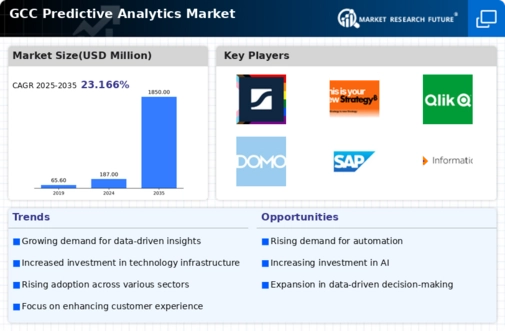Increased Focus on Customer Experience
In the GCC, there is an increasing focus on enhancing customer experience, which is driving the predictive analytics market. Organizations are utilizing predictive analytics to understand customer behavior and preferences, allowing them to tailor their offerings accordingly. This trend is particularly pronounced in the retail and hospitality sectors, where personalized experiences can lead to higher customer satisfaction and loyalty. By analyzing customer data, businesses can predict future buying patterns and optimize their marketing strategies. The predictive analytics market is projected to witness a growth rate of around 20% annually as companies prioritize customer-centric approaches. This shift towards personalization is reshaping how businesses interact with their customers, making predictive analytics an indispensable tool.
Emergence of Smart Technologies and IoT
The emergence of smart technologies and the Internet of Things (IoT) is reshaping the predictive analytics market in the GCC. As more devices become interconnected, the volume of data generated is increasing exponentially. Predictive analytics plays a crucial role in processing this data to derive meaningful insights. Industries such as manufacturing and logistics are leveraging IoT data to optimize operations and predict maintenance needs. The integration of predictive analytics with IoT is expected to create a market worth approximately $4 billion by 2028. This convergence not only enhances operational efficiency but also enables organizations to innovate and adapt to changing market dynamics. As smart technologies continue to evolve, the predictive analytics market is likely to expand, offering new avenues for growth.
Regulatory Compliance and Risk Management
Regulatory compliance and risk management are becoming increasingly critical in the GCC, thereby impacting the predictive analytics market. Organizations are required to adhere to stringent regulations, particularly in sectors such as finance and healthcare. Predictive analytics provides the tools necessary to assess risks and ensure compliance with regulatory standards. By utilizing predictive models, companies can identify potential compliance issues before they escalate, thus mitigating risks effectively. The market for predictive analytics in risk management is expected to grow significantly, with estimates suggesting a value of $3 billion by 2027. This focus on compliance not only enhances operational integrity but also fosters trust among stakeholders, further driving the adoption of predictive analytics.
Rising Demand for Data-Driven Decision Making
The predictive analytics market is experiencing a surge in demand. Organizations in the GCC increasingly recognize the value of data-driven decision making. Businesses are leveraging predictive analytics to enhance operational efficiency and improve customer experiences. According to recent estimates, the market is projected to grow at a CAGR of approximately 25% from 2025 to 2030. This growth is driven by the need for organizations to analyze vast amounts of data to derive actionable insights. As companies strive to remain competitive, the integration of predictive analytics into their strategic frameworks becomes essential. This trend is particularly evident in sectors such as retail and telecommunications, where data insights can lead to improved customer engagement and retention strategies.
Technological Advancements in Machine Learning
Technological advancements in machine learning are significantly influencing the predictive analytics market. The introduction of sophisticated algorithms and tools enables organizations in the GCC to analyze complex datasets more effectively. Machine learning techniques, such as neural networks and decision trees, are being utilized to enhance predictive accuracy. This is particularly relevant in industries like finance and healthcare, where predictive models can forecast trends and identify potential risks. The market for machine learning in predictive analytics is expected to reach approximately $5 billion by 2026, indicating a robust growth trajectory. As organizations continue to invest in these technologies, the predictive analytics market is likely to expand, offering new opportunities for innovation and efficiency.

















Leave a Comment